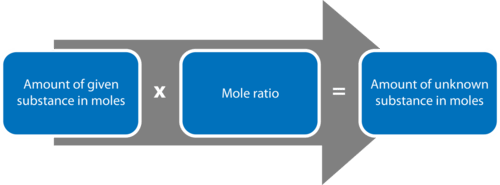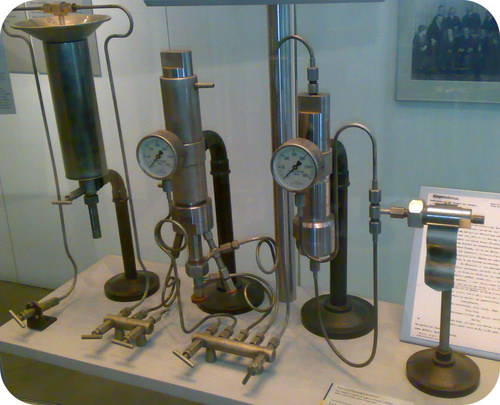分子比率
章节大纲
-
What does this porch need?
::这个门廊需要什么?You want to add some sections to the porch seen above. Before you go to the hardware store to buy lumber, you need to determine the unit composition (the material between two large uprights). You count how many posts, how many boards, how many rails – then you decide how many sections you want to add before you calculate the amount of building material needed for your porch expansion.
::您想要在前面的门廊添加部分。 在您去五金商店购买木材之前, 您需要确定单位构成( 两种大平面之间的材料 ) 。 您要计算多少个柱子, 多少板子, 多少条铁轨 — — 然后在计算门廊扩张所需的建筑材料数量之前决定您想要添加多少个区块 。Mole Ratios
::分子比率Stoichiometry problems can be characterized by two things: (1) the information given in the problem, and (2) the information that is to be solved for, referred to as the unknown . The given and the unknown may both be reactants , both be products, or one may be a reactant while the other is a product. The amounts of the substances can be expressed in moles . However, in a laboratory situation, it is common to determine the amount of a substance by finding its mass in grams. The amount of a gaseous substance may be expressed by its volume . In this concept, we will focus on the type of problem where both the given and the unknown quantities are expressed in moles.
::口服测量问题可以有两点特征1) 问题中提供的信息,(2) 需要解决的信息,称为未知信息; 给与未知信息,既可以是反应剂,既是产品,也可以是反应剂,而另一个是产品; 物质的数量可以用内核表示; 然而,在实验室中,通过找到质量以克表示确定物质的数量是常见的; 气体物质的数量可以用其体积表示; 在这个概念中,我们将侧重于给与和未知数量以内核表示的问题类型。
Mole ratio relationship.
::分子比例关系。Chemical equations express the amounts of in a reaction. The coefficients of a balanced equation can represent either the number of molecules or the number of moles of each substance. The production of ammonia (NH 3 ) from nitrogen and hydrogen is an important industrial reaction called the Haber process, after German chemist Fritz Haber.
::化学方程式表示反应中的数量。平衡方程式的系数可以代表分子数量或每种物质的摩尔数量。用氮和氢生产氨(NH3)是一个重要的工业反应,在德国化学家弗里茨·哈伯之后称为哈伯过程。
::N2(g)+3H2(g)=2NH3(g)The balanced equation can be analyzed in several ways, as shown in Figure .
::如图6所示,平衡方程式可以用几种方式分析。This representation of the production of ammonia from nitrogen and hydrogen show several ways to interpret the quantitative information of a chemical reaction.
::从氮和氢中生产氨的这种表示方式显示了解释化学反应的定量信息的若干方法。We see that 1 molecule of nitrogen reacts with 3 molecules of hydrogen to form 2 molecules of ammonia. This is the smallest possible relative amounts of the reactants and products. To consider larger relative amounts, each coefficient can be multiplied by the same number. For example, 10 molecules of nitrogen would react with 30 molecules of hydrogen to produce 20 molecules of ammonia.
::我们看到,1个氮分子与3个氢分子发生反应,形成2个氨分子,这是反应器和产品的最小相对数量。考虑到较大的相对数量,每个系数可以乘以相同数量。例如,10个氮分子与30个氢分子发生反应,产生20个氨分子。The most useful quantity for counting particles is the mole. So if each coefficient is multiplied by a mole, the balanced chemical equation tells us that 1 mole of nitrogen reacts with 3 moles of hydrogen to produce 2 moles of ammonia. This is the conventional way to interpret any balanced chemical equation.
::计算粒子最有用的数量是摩尔。因此,如果每个系数乘以一个摩尔,平衡的化学方程式告诉我们,1毫尔的氮与3毫尔的氢反应产生2毫尔的氨。这是解释任何平衡化学方程式的常规方法。Finally, if each mole quantity is converted to grams by using the , we can see that the is followed. 1 mol of nitrogen has a mass of 28.02 g, while 3 mol of hydrogen has a mass of 6.06 g, and 2 mol of ammonia has a mass of 34.08 g.
::最后,如果每个摩尔的数量通过使用(......)转换成克,我们可以看到它被跟随。 1毫升氮的重量为28.02克,3毫升氢的重量为6.06克,2毫升氨的重量为34.08克。
::28.02克N2+6.06克H234.08克NH3Mass and the number of atoms must be conserved in any . The number of molecules is not necessarily conserved.
::质量和原子数量必须保存在任何 。 分子数量不一定保存在保存中 。Apparatus for running Haber process.
::运行 Haber 进程的设备 。A mole ratio is a conversion factor that relates the amounts in moles of any two substances in a chemical reaction. The numbers in a conversion factor come from the coefficients of the balanced chemical equation. The following six mole ratios can be written for the ammonia forming reaction above.
::摩尔比是一个转换系数,它与化学反应中任何两种物质的摩尔数量相关。换算系数中的数字来自平衡化学方程式的系数。以下六摩尔比率可以写作上面氨的反应。
::1 mol N23 mol H2or 3 mol H21 mol N21 mol N21 mol N22 mol NH3or 2 mol NH31 mol N23 mol H22 mol H3or 2 mol NH33 mol H2In a mole ratio problem, the given substance, expressed in moles, is written first. The appropriate conversion factor is chosen in order to convert from moles of the given substance to moles of the unknown.
::在摩尔比率问题中,以摩尔表示的给定物质首先写成。选择适当的换算系数是为了将给定物质的摩尔转换成未知的摩尔。Sample Problem: Mole Ratio
::样本问题: 分子比率How many moles of ammonia are produced if 4.20 moles of hydrogen are reacted with an excess of nitrogen?
::如果4.20摩尔的氢与过量的氮反应产生反应,会产生多少氨的摩尔?Step 1: List the known quantities and plan the problem.
::第1步:列出已知数量并规划问题。Known
::已知已知-
given: H
2
= 4.20 mol
::说明:H2=4.20毫毫升
Unknown
::未知-
mol of NH
3
::NH3 mol mol 3 NH3
The conversion is from mol H 2 → NH 3 . The problem states that there is an excess of nitrogen, so we do not need to be concerned with any mole ratio involving N 2 . Choose the conversion factor that has the NH 3 in the numerator and the H 2 in the denominator.
::转换来自 mol H2 NH3 。 问题显示氮过多, 因此我们不需要关注任何涉及N2的摩尔比。 选择分子中带有NH3的转换系数, 分母中含有H2的转换系数 。Step 2: Solve.
::步骤2:解决。
::4.20摩尔 H2x2摩尔 NH33摩尔 H2=2.80摩尔 NH3The reaction of 4.20 mol of hydrogen with excess nitrogen produces 2.80 mol of ammonia.
::4.20毫升氢与超量氮的反应产生2.80毫升氨。Step 3: Think about your result.
::步骤3:想想你的结果。The result corresponds to the 3:2 ratio of hydrogen to ammonia from the balanced equation.
::其结果相当于平衡方程中氢对氨的3:2比。Summary
::摘要-
Mole ratios allow comparison of the amounts of any two materials in a balanced equation.
::分子比率允许在平衡方程中比较任何两种材料的数量。 -
Calculations can be made to predict how much product can be obtained from a given number of moles of reactant.
::可以进行计算,预测从一定数量的反应剂的摩尔获得多少产品。
Review
::回顾-
If a reactant is in excess, why do we not worry about the mole ratios involving that reactant?
::如果反应器超量,为什么我们不担心该反应器的摩尔比率? -
What is the mole ratio of H to N in the ammonia molecule?
::氨分子中H对N的摩尔比是多少? -
The formula for ethanol is CH
3
CH
2
OH. What is the mole ratio of H to C in this molecule?
::乙醇的配方是CH3CH2OH。在这个分子中,H对C的摩尔比是多少?
-
given: H
2
= 4.20 mol



